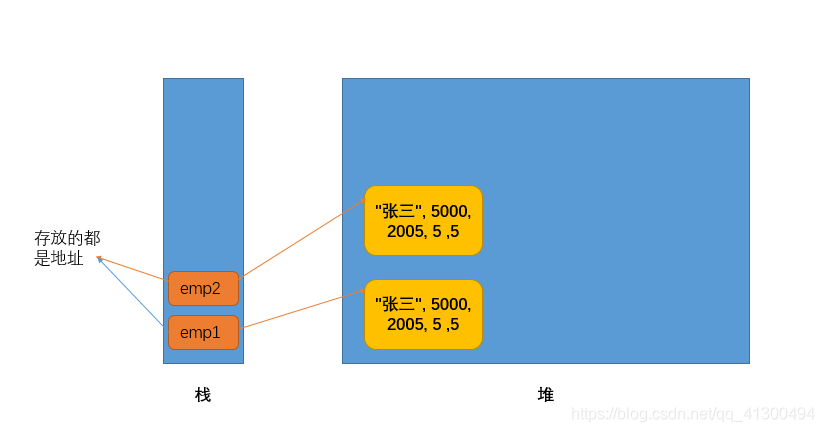1. First, let’s look at the equals method
in Object class
public boolean equals(Object obj) {
return (this == obj);
}
we can see if the Object class is judging the same Object, let’s take a look at the following example
Employee emp1 = new Employee("张三", 5000, 2005, 5 ,5);
Employee emp2 = new Employee("张三", 5000, 2005, 5 ,5);
System.out.println(emp2.equals(emp1));
stop here and think about what’s going to come out?
, I’m sure a lot of beginners like me think it will output true. But the answer is false. Why?We’re looking at the only line of code in the body of the method
return (this == obj);
, what does this==obj stand for?In fact, what we’re doing here is determining whether this is the same address as obj, or whether it’s the same object in the heap.

it is easy to see that emp1 and emp2 do not store the same address in the stack, so it will print false.
2. Next, let’s look at the equals method in the String class
public boolean equals(Object anObject) {
//判断是否同一个对象
if (this == anObject) {
return true;
}
//判断anObject 是否是String的实例对象
//如果是的话判断两个String对象的长度是否相等
//如果相等再判断每一个字符是否相等
if (anObject instanceof String) {
String anotherString = (String)anObject;
int n = value.length;
if (n == anotherString.value.length) {
char v1[] = value;
char v2[] = anotherString.value;
int i = 0;
while (n-- != 0) {
if (v1[i] != v2[i])
return false;
i++;
}
return true;
}
}
return false;
}
The equals method in the
String class does two things. The first method is the same as the equals method in Object. If not the same object, then determine whether the length is equal, then determine whether each character is equal.
Read More:
- Override the equals method and override the toString method
- On the intern () method of string class in Java
- Solve the problem that power view in Excel prompts activate method of oleobject class failed or activate method like oleobject is invalid
- Generating equals/hashCode implementation but without a call to superclass
- Difference between isempty method and isblank method in stringutils
- The solution to the problem that the method of interacting with database in the servlet class is invalid after the servlet submits 404, 500 refresh and becomes 404, and after connecting to the data pool
- Android studio displays the class and method where the cursor is located
- Method of ignoring case in Python string comparison
- Power view error: invalid activate method of class oleobject
- Mybatis error,There is no getter for property named ‘xx’ in ‘class java.lang.String The solution
- JavaScript summary: the difference between typeof and instanceof, and Object.prototype.toString() method
- C++ foundation — clear/erase/pop of string class_back
- “class“ object is not subscriptable
- Differences between length() size() and C strlen() of C + + string member functions
- “Method does not override method from its superclass”
- The shell runs the class file and imports the jar package that the class depends on
- Tensorflow in function tf.Print Method of outputting intermediate value
- The method of getting shell command output in Python
- Error c2011: “a certain class”: redefinition of “class” type
- C++ Error: allocating an object of abstract class type